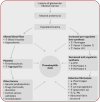Nephrotic Syndrome Complications - New and Old. Part 1
- PMID: 35733752
- PMCID: PMC9168581
- DOI: 10.26574/maedica.2022.17.1.153
Nephrotic Syndrome Complications - New and Old. Part 1
Abstract
Nephrotic syndrome is a rare condition with an incidence of 2-7 cases/100.000 children per year and three new cases/100.000 adults per year. It occurs as a result of severe alteration of the glomerular filtration barrier of various causes, allowing proteins, mostly albumin, to be lost in the urine. Nephrotic syndrome complications are driven by the magnitude of either proteinuria or hypoalbuminemia, or both. Their frequency and severity vary with proteinuria and serum albumin level. Besides albumin, many other proteins are lost in urine. Therefore, nephrotic patients could have low levels of binding proteins for ions, vitamins, hormones, lipoproteins, coagulation factors. The liver tries to counterbalance these losses and will increase the unselective synthesis of all types of proteins. All of these changes will have different clinical consequences. The present paper aims to discuss the pathophysiological mechanism and new therapeutic recommendations for nephrotic syndrome edema and thromboembolic complications.
Figures









References
-
- Glassock RJ, Fervenza FC, Hebert L, Cameron JS. Nephrotic syndrome redux. Nephrology Dialysis Transplantation. 2015;30:1217. - PubMed
-
- Wilmer WA, Rovin BH, Hebert CJ, et al. Management of glomerular proteinuria: a commentary. J Am Soc Nephrol. 2003;14:3217–3232. - PubMed
-
- Praga M, Borstein B, Andres A, et al. Nephrotic proteinuria without hypoalbuminemia: clinical characteristics and response to angiotensin-converting enzyme inhibition. Am J Kidney Dis. 1991;17:330–338. - PubMed
-
- Kaysen GA. Albumin metabolism in the nephrotic syndrome: the effect of dietary protein intake. Am J Kidney Dis. 1988;12:461–480. - PubMed
-
- Donckerwolke RA. The nephrotic syndrome: Management, complications and pathophysiology. In: Oxford Textbook of Clinical Nephrology, Vol. 1, 3rd ed., Davison AM et al (eds), Oxford University Press, 2005, pp. 415-438.
Publication types
LinkOut - more resources
Full Text Sources
